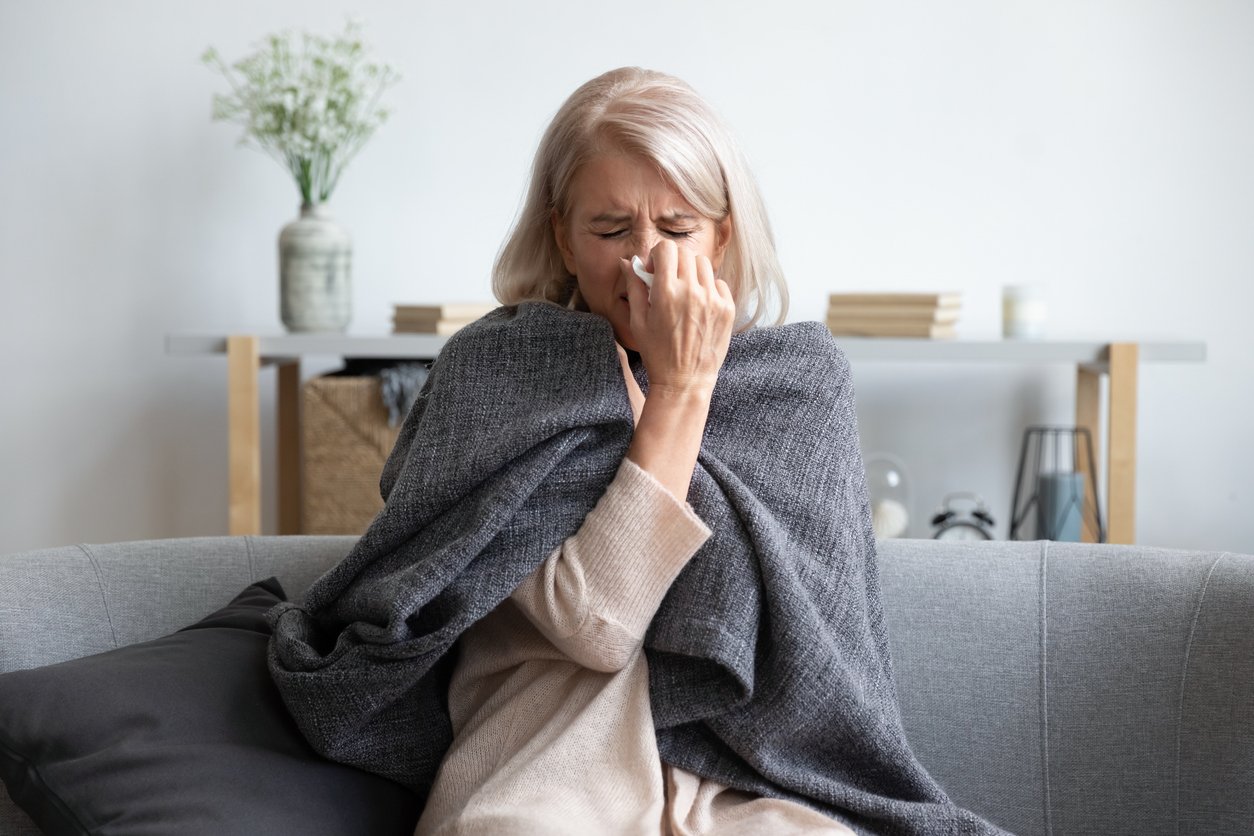Imagine a society in which the universal custom was to hit oneself on the head with a hammer three times a day. (Outlandish, right? Stay with me though.)
You’d first notice that everyone’s heads would always hurt. They’d probably take painkillers, starting with mild over-the-counter drugs and graduating to higher and higher doses of more powerful prescriptions.
Over time, many of them would also probably experience side effects from the painkillers, such as nausea, rashes, shortness of breath, vomiting, weight gain, diarrhea, constipation, and others. As a result, those suffering from uncomfortable side effects might start taking additional medications to manage the symptoms caused by the painkillers.
All of this is to say that if people just stopped hitting themselves over the head with a hammer in the first place, before long, they wouldn’t have to treat their head pain and the subsequent side effects from painkillers.
While this is a dramatic and far-fetched scenario, the concept is not far from the situation many Americans face regarding their health. But instead of hitting themselves on the head with hammers three times a day, most people are (often unknowingly) damaging their bodies through their lifestyle choices.
While the multi-trillion dollar mainstream healthcare system focuses on pain and symptom management, and the pharmaceutical industry searches for chemical cures (imagine a drug that could make your head impervious to chronic cranial impact syndrome!), the truth is that a huge portion of the burden of chronic disease can be prevented or reversed through improvements in diet, exercise, and other lifestyle choices.
Despite vast spending to address the issue of chronic disease (in the United States, over 17% of our GDP — $4.5 trillion per year — goes to healthcare), its incidence is at a record high. Currently, more than 70 million Americans are living with at least one chronic health condition, such as heart disease, hypertension, diabetes, or dementia. And if we don’t change course, this number is expected to double in the next generation.
Modern Healthcare Is Failing Us

Modern medicine has undoubtedly improved our lives in many ways. It’s extremely effective in dealing with acute injuries and accidents. The use of antibiotics has transformed formerly deadly infections into easily treatable conditions. Better diagnostic techniques mean that many issues can be treated early, with far greater chances of success.
That said, it’s also true that, in many ways, modern medicine has failed to keep many of us healthy or happy. A 2023 survey found that three-quarters of respondents in the US said the healthcare system wasn’t meeting their needs.
When you consider the imaginary society where people smack their heads with hammers, it’s easy to see the solution: they need to put down the darn hammers!
There’s also a prevention-focused solution in the real world. The healthcare system can provide much better care by targeting the root causes of chronic diseases through a holistic approach to wellness.
Lifestyle Medicine is a growing field that addresses these conditions at their core, helping patients regain control of their health through manageable, holistic changes.
What Is Lifestyle Medicine?
Lifestyle medicine was first recognized as a medical specialty in 2004 and is now one of the fastest-growing medical specialties in America, with international interest as well.
The American College of Lifestyle Medicine (ACLM) defines lifestyle medicine as “a medical specialty that uses therapeutic lifestyle interventions as a primary modality to treat chronic conditions including, but not limited to, cardiovascular diseases, type 2 diabetes, and obesity.”
They teach patients how to put down metaphorical hammers (unhealthy diets, cigarettes, sedentarism, poor sleep, loneliness, and unmanaged stress) so their bodies can heal. Clinicians apply evidence-based, whole-person, prescriptive lifestyle changes to treat chronic conditions. Often, this approach can slow, arrest, and, when used intensively, even reverse such conditions.
Lifestyle medicine also aims to be a preventive discipline. Rather than waiting until patients develop life-threatening conditions, guiding them to implement the pillars of lifestyle medicine can keep them from getting sick in the first place.
There are six pillars of lifestyle medicine:
- a whole-food, plant-predominant eating pattern
- physical activity
- restorative sleep
- stress management
- avoidance of risky substances
- positive social connections
Why Lifestyle Medicine Is a Key Solution to Our Healthcare Crisis

Lifestyle medicine uses the six pillars to help prevent and even treat the root causes of many conditions. It places the patient, not medications or procedural treatments, at the center of health care.
This is an important point since half of people surveyed by the American Academy of Physician Associates in 2023 said they didn’t always feel listened to by healthcare providers. And that kind of makes sense if a physician’s job is to “give” health in the form of pills or procedures.
However, if the doctor’s job is to help patients feel better and get healthier, it might also be important to listen and learn what lifestyle factors influence their patients’ health. That curiosity might bridge the current disconnect and allow healthcare providers and patients to form a stronger partnership.
What might be the outcome if lifestyle medicine became the approach of first resort in the healthcare system?
Some researchers estimate that approximately 80% of chronic diseases and premature deaths could be prevented by just three of the six pillars: not smoking, being physically active, and adhering to a healthy dietary pattern.
There’s overwhelming evidence that lifestyle choices influence cardiovascular disease, type 2 diabetes, stroke, dementia, and cancer. Lifestyle medicine can reduce the need for expensive medical treatments by preventing and reversing disease, and improving health outcomes. Indeed, initial studies show that lifestyle interventions could provide a much better return on investment than the current mainstream approaches.
Not only do holistic approaches save money and improve health outcomes, but they also improve patient satisfaction, increase the job satisfaction reported by healthcare workers, and deliver healthcare more equitably across the population.
In short, lifestyle medicine can be a win-win-win for patients, providers, and society as a whole.
Addressing Health Disparities With Lifestyle Medicine
“If living were a thing that money could buy
The rich would live, and the poor would die.”
— “All My Trials” (traditional gospel song)
Money may not buy life, but it sure can help prolong it. Statistically, in the US, white people tend to be more financially stable and have lower rates of mortality from chronic disease than other racial groups.
Black and Hispanic Americans are about twice as likely as white Americans to develop Alzheimer’s or another dementia, and African Americans are far more likely to die from heart disease than non-Hispanic white Americans.
This disparity extends far beyond “lifestyle choices” like diet or exercise. So-called “social determinants of health,” such as limited access to healthcare, healthy food options, and safe spaces for physical activity, can shape the health outcomes for members of a community.
It’s estimated that healthcare disparities in the US cost ethnic minorities $451 billion every year. That’s 2% of the US gross domestic product, ripped away from some communities that can least afford to lose it. This is a major driver of the wealth gap that all too often persists along lines of race.
So, how can lifestyle medicine address this injustice?
Well, for one thing, its focus on preventing and reversing disease can reduce long-term healthcare costs, making it accessible for lower-income populations.
Second, the treatments are far cheaper than the standard medical fare of drugs and surgeries. A coronary bypass operation can cost up to $200,000, but prescribing a plant-based diet can avoid the need for such an operation and can be far more cost-effective.
Whole, plant-based foods like legumes, grains, fruits, and vegetables can be more affordable than processed foods and animal products, making them an accessible option for many underserved communities.
Also, community-based interventions and education that utilize the six pillars can empower historically marginalized communities. Given the knowledge and tools to make healthier choices, they can take back their agency and take control of their health, leading to improved health outcomes and reduced health disparities.
ACLM’s Health Equity Achieved through Lifestyle Medicine (HEAL) Initiative is one lifestyle medicine program that addresses health disparities and culturally appropriate care in communities of color.
Impact on the Medical Education System

So why is it that so many doctors are quick to turn to expensive drugs and procedures that treat symptoms rather than inexpensive lifestyle interventions? One of the main reasons is what they’re exposed to during their medical education.
The traditional medical curriculum gives little more than lip service to preventive care or lifestyle-related health, especially nutrition. Most medical students receive fewer than 20 hours of nutritional education over four years of medical school. Much of that focuses on treating vitamin and mineral deficiencies rather than the healing power of whole, plant-based foods for chronic conditions.
Times are changing, though. Many schools and medical programs are beginning to integrate lifestyle medicine into their curriculum. The changes are not just top-down; more and more students believe in and advocate for a more lifestyle-oriented approach.
Over the past couple of years, Congress and the executive branch have even made efforts to raise awareness about the need to increase nutrition education in US medical schools. They’ve taken concrete steps, such as H. Res 784, a bi-partisan resolution “that calls for medical schools, residency, and fellowship programs to provide nutrition education that demonstrates the connection between diet and disease.”
ACLM provides additional education and certification for healthcare providers. ACLM now has more than 13,500 members. Since certification began in 2017 by the American Board of Lifestyle Medicine, 3,075 physicians in the US have become board-certified in lifestyle medicine, along with 1,263 other health professionals. Worldwide, across 75 countries, 5,017 physicians and 1,671 other clinicians are certified for a total of 6,688.
In 2021, ACLM launched the Health Systems Council to support the growing implementation of lifestyle medicine into some of the largest and most innovative US health organizations. As of this writing, the council has 115 members in 37 US states.
I’m delighted to report that Food Revolution Network has also played a part in bringing nutrition education into medical schools. We partnered with Bright Line Eating and ACLM to create (and raise the funds necessary for) the Lifestyle Medicine Undergraduate Medical Education Question Bank.
The campaign’s goal was to get lifestyle medicine test questions on categorical assessment tests and licensing exams, motivating medical schools to include lifestyle medicine subjects in their curricula. We needed to raise $250,000 to reach our goal of 1,000 questions, and we reached it on December 22, 2019!
ACLM faculty now use the 1,000 questions to educate and test medical school students about lifestyle medicine.
If enough medical schools use this question bank, we hope that the National Board of Medical Examiners, which administers tests for medical schools across the US, will make some of these questions a core part of the required testing.
If or when that happens, medical schools, which teach to the test, will change curricula significantly.
Plant-Based Coaching
One of the most important components of lifestyle medicine is whole food, plant-based nutrition. There’s a huge body of evidence that healthy food choices can play a big role in the state of your health.
Multiple studies show that plant-based diets, in particular, can reduce the risk of heart disease, type 2 diabetes, certain cancers, and other lifestyle-related diseases — making them a powerful tool for prevention, management, and even disease reversal.
Awareness of the benefits of whole food, plant-based diets is growing, too. Entertaining documentaries, celebrity endorsements, influencer content, and non-fiction books are spreading the message into the mainstream.
But just because people know that changing their diet can improve their health doesn’t mean that they’ll be able to do it. Many factors can stop people from doing better once they know better: social pressures, unfamiliar tastes, cultural and family traditions, food addictions, and lack of experience with new culinary techniques and ingredients, to name just a few.
That’s why, along with the rise of lifestyle approaches to medicine, the need for specialized coaching that helps individuals adopt and sustain plant-based lifestyles is also increasing. More and more certified plant-based coaches have set up practices within healthcare and on their own to help patients and clients transition to healthier diets.
ACLM also integrates plant-based nutrition into its professional training programs. The coaches they certify are trained and equipped to guide clients’ transitions to healthier lifestyle patterns in the face of the obstacles we just examined. (Find out more about ACLM’s Lifestyle Medicine for Coaches here.)
Again, I’m pleased to report that the Food Revolution Network is contributing to the growth of this field by offering a Plant-Based Coaching Certification.
This program is designed for those who want to guide others toward optimal health using evidence-based, plant-based nutrition principles. The certification covers the science behind plant-based diets and coaching techniques that can help individuals make sustainable changes in their eating habits. It also covers strategies for impact, including entrepreneurship, employment, and being a changemaker. (Find out more about FRN’s Plant-Based Coaching Certification.)
The Future of Healthcare With Lifestyle Medicine

The future of healthcare looks to be a prevention-oriented model driven by the principles of lifestyle medicine.
While progress has been slow, things are ramping up as the seeds that have been sown produce visible results. For example, plant-based diets and other pillars of lifestyle medicine are now recommended for treating and even reversing heart disease in certain patients, a protocol whose efficacy was demonstrated in the late 1980s by renowned lifestyle medicine trailblazer Dr. Dean Ornish.
These days, the Ornish Program, once viewed with suspicion by the medical mainstream, is covered by major insurance providers.
Similarly, the World Health Organization (WHO) recently recognized the contribution lifestyle medicine can make to improving public health.
The WHO has invited the Lifestyle Medicine Global Alliance, created in 2016 as a global initiative of the ACLM, to partner with them to reduce noncommunicable diseases by 30% by 2030.
Lifestyle medicine is even being incorporated into New York City’s Public Health Care System, one of the largest metropolitan systems in the world. Insurance companies are starting to cover other lifestyle interventions, such as nutritional counseling and wellness programs, that were previously overlooked.
These changes are being driven by the cost-effectiveness of prevention over costly treatments. Fortunately, lifestyle medicine programs are also effective at making people healthier overall — which makes their results appealing to patients who don’t just want to live longer but who also want to live better.
The success of these programs in the US is drumming up demand elsewhere. For example, structured lifestyle interventions are now available throughout the Arab world. Those who have combined behavioral therapy with personalized goals have led to significant improvements in health outcomes.
A large-scale lifestyle medicine program in Finland with over 10,000 participants succeeded in lowering the risk of developing type 2 diabetes by 29–37% in those who dropped 2.5% of their body weight over the course of the program.
It’s Time for a Lifestyle Medicine Revolution!
Lifestyle medicine allows individuals to take charge of their health through changes in diet, activity level, sleep, stress, substances, and social connections. Individuals enhance their well-being and contribute to a broader shift in healthcare culture.
Each of us can participate in the lifestyle medicine revolution as patients, practitioners, and/or advocates. When we do, we’re helping to build healthier lives, a healthier society, and a healthier future for humanity.
Featured Image: iStock.com/andreswd



